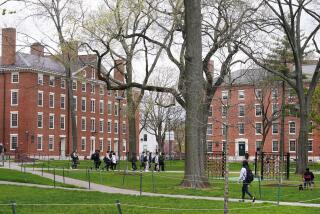Way That Grades Are Set Is a Mark Against Professors
- Share via
Are today’s college professors easier graders than yesterday’s college professors? Are they giving away grades? Consider the following:
* In 1966 at Harvard, 22% of all grades were A’s; in 2003, 46% of all grades were A’s. Similarly, a UCLA study reports that in 1968, 22% of all grades at 18 colleges and universities were A’s, but by 2002 that percentage had risen to 47%.
* A recent Princeton University study reports that between 44% and 55% of all grades at the Ivy League schools, MIT, Stanford and the University of Chicago are A’s today.
*Less than 10% of all grades given out at Duke University are Cs, according to an article by Duke professor Stuart Rojstaczer; in 1969, more than 25% were.
Of course, grading is subjective, but what explains the changing grade distribution over time?
One theory says today’s students are smarter (and perhaps harder-working too) than yesterday’s students. It’s a nice idea, but so far there is absolutely no evidence to support this theory. If anything, there is some evidence to the contrary. The mean combined SAT score was 1,059 in 1967 and 1,020 in 2002. Add to this the fact that the SAT was reconfigured in 1995, effectively adding 100 points to the score of everyone who took the test after this date.
Then there is the “better professor” theory, which says today’s professors are more effective than yesterday’s professors at getting their students to learn. As far as I know, no one has put forth any evidence to support this theory either.
If neither better students nor better professors explain the changing grade distribution, then what does?
The answer, quite obviously, is that professors have been inflating grades.
Who does grade inflation hurt? For one, it hurts the true A student, who would have received an A even if grades had not been inflated.
Consider a class of 50 students in which 10 students receive A’s, 10 students receive Bs, and so on through C, D, and F. The A student is in the top 20% of this class. Now introduce grade inflation; compress those 50 students into a grading system of A through D. The true A student is one of 20 A students, or in the top 40% of the class.
But grade inflation also reflects a decline in standards that we should be worried about. When more than half of all grades are A, it is unlikely that any rigorous standard is being satisfied. Grade inflation is symptomatic of a profession that no longer is discerning enough to separate according to degrees of merit.
Some say the seeds of grade inflation were planted during the Vietnam War era. College students with draft deferments persuaded their college professors to pass them, in order to avoid finding themselves headed for the jungles of Vietnam.
Others say the true culprit is today’s student course evaluations. A professor whose tenure and promotion decision even slightly depends on student course evaluation scores is a professor who wants his students to like him.
On just about every college campus today, you hear professors decrying grade inflation. So, then, why don’t they end it?
Professors are in a grade inflation trap. If only one professor discontinues inflating grades, he is just putting his students at a disadvantage relative to other students. While the vast majority of professors are giving A’s for C-plus work, he gives a C-plus for C-plus work.
To this end, officials at Princeton have proposed limiting the number of A’s that professors may give to students. This may be the best method available to universities to escape from the grade inflation trap that they have been stuck in for approximately four decades.
Grade inflation will not end until a large group of professors agrees to stop inflating grades and figures out a way to enforce the agreement.
Roger A. Arnold is professor of economics at Cal State San Marcos.
More to Read
Sign up for Essential California
The most important California stories and recommendations in your inbox every morning.
You may occasionally receive promotional content from the Los Angeles Times.













